Fight for the Mediterranean. Fight at Cape Matapan
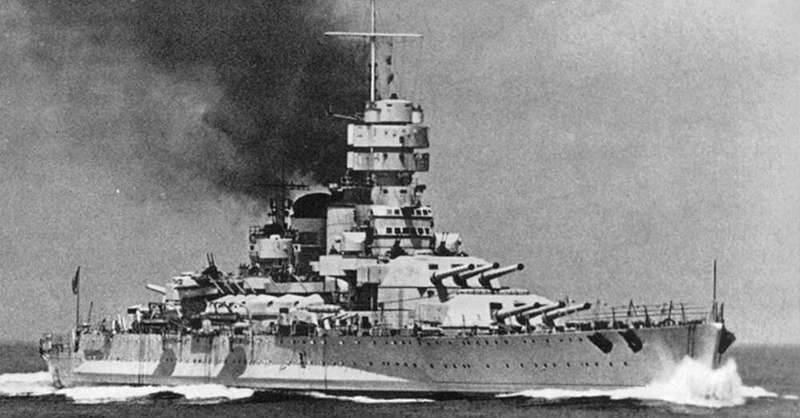
The fortieth President of the Council of Ministers of Italy, concurrently Duce of fascism and the founder of the Empire, Benito Mussolini, full of greatness, showed with his hand to his guest the columns marching in front of the stands. Printing “Passo Romano”, the Italian version of the “goose pace”, into the land that remembers Caesar’s legions so well, the infantry passed the battalion after the battalion: plain and colonial, bersaliers, alpine shooters, black shirts. The audience applauded loudly and shouted “Bravo!” With her usual temperament. The guest nodded politely, frowned ... Maybe he was tired, or maybe he was just annoyed by this pathos parade, somewhat reminiscent of Verdi's opera with a carnival tinge. The abundance of bright and expensive uniforms in the stands contrasted strikingly with riveted tanks, archaic armored cars and guns of the end of the First World War. Adolf Hitler (namely, he was a guest of the Duce who visited the allied Rome in May 1938) was disappointed. Mussolini, like Moliere’s Petty Bourgeois in the nobility, struggled to pull by no means the most advanced country into the big leagues, for a game in which Italy had neither the strength nor the means - only ambition, reinforced by self-association with the Roman Empire.
New Romans
Duce craved glory. But with this value somehow did not develop. Puffing and straining, the Italian army finally defeated ancient Ethiopia without disregarding the use of poison gases against troops, partly armed with flint-guns and bows. Pompous expeditionary corps sent to Spain suffered huge losses with dubious results. The construction of the Empire turned out to be a matter of not only troublesome, but also expensive, and also dangerous. From the great war that began in Europe, Italy tactfully withdrew at first, because the armies and fleets of England and France were far more dangerous for the “descendants of the ancient Romans” than the “African savages”. So far, Rome has confined to the bursting rhetoric about the inviolability and inviolability of friendship with Germany. The rapid collapse of the Allied western front impressed Mussolini — the cake was nourished quickly, so that you could not make it to the table. With a delay of almost a month, 10 June 1940, Italy declared war on the Anglo-French coalition.
In vain did the marshals and generals persuade Mussolini not to get stuck in the campaign that was actually ending. Neither the state nor its army was ready for such a large-scale fulfillment of the claims of the Duce. Almost 40% of Italian shopping fleet It was located outside Italy, out of a list of 73 divisions that were actually combat-ready and fully staffed, there were only 19. There were no long-term supplies of strategic raw materials, ammunition, and other military equipment. But Mussolini had his lip stuck out. The fighting in the Alps boiled down to sporadic shootouts of patrols and shelling. An attempt to conduct an offensive deep into French territory was unsuccessful. However, the role of the extras in this part of the global conflict allowed Italy to get a piece, albeit modest, from German production.
While in Berlin they calculated how much the maintenance of an ally would cost them, the tireless Mussolini was already carrying plans for an invasion of Greece from the territory of previously occupied Albania. The founder of the Empire was very unhappy that his ally was not in a hurry to coordinate his plans with such an important person. In addition, the Duce tried with all his might to show everyone (maybe, first of all to himself) that “the descendants of the proud Romans” inherited not only the ability to make magnificent parades in peacetime, but also to win victories in the wartime. After the growing diplomatic onslaught and a series of provocations, the Italians of October 28 launched an offensive, which, however, soon triumphantly drowned - armed with an even older one. weaponsthan the enemy, the Greek army threw the aggressor into the territory of Albania. Upon hearing of the ally’s military action, Hitler was infuriated - the inconvenient strategy situation in the Balkans interfered with his ambitious plans for a promising campaign in the East. It was also impossible to let things take their course, in Berlin they were clearly aware that any enemy of the Axis countries automatically became an ally of England under siege. Winter 1940 – 1941 brought a lull to the mountainous Balkan front, and then the German and Italian intelligence received information about sending the British expeditionary force to Greece. The English convoys moved to the shores of Hellas, and the Italian fleet seemed to have the opportunity to influence what was happening.
Favorite child of Duce
If regarding the army construction and ground forces in general, the successes of the fascists were quite controversial (in general, the unsuccessful reforms of General Alberto Pariani contributed greatly to this), the navy could boast, at first glance, more significant achievements. On paper, the royal naval forces were quite impressive: at the time of entry into the war, they counted 4 battleship, 7 heavy, 15 light cruisers, 127 destroyers and destroyers, 121 submarine. The Italian shipbuilding school is rightfully recognized as one of the best in Europe, if not in the world, then for sure. Foreign customers, in particular, the USSR, readily resorted to its services.
In fact, the situation was less rosy. Mussolini's beloved brainchild and pride, the fleet was not ready for war. Of the four battleships, which were also deeply modernized veterans of the First World War, only two were combat-ready (Giulio Cesare and Cavour). The other two (Cayo Duilio and Andrea Doria) have not yet completed modernization in Genoa and Trieste. In summer, however, the launch of the newest Littorio and Vittorio Veneto, high-speed ships equipped with 380 mm artillery, was expected. The heavy cruisers were a high-speed variation of the Washingtonians, and three of the light ones were participants in the First World War (two of them, Taranto and Bari, were former German transferred to Italy by reparations). Italian submarines were distinguished by poor maneuverability under water and high noise. The technical equipment of the fleet (anti-aircraft weapons, fire control devices, etc.) was generally outdated. The Italian sailors had the most common and also vague idea of radar. Many ships (in particular, 12 light cruisers of the Captain Romani type) were at different stages of construction. There were no aircraft carriers in the fleet - it was believed that their function would be successfully handled aviation coast-based. A dangerous delusion, which the Italians then had to repeatedly make sure of through bitter experience. With the outbreak of war, when the export of oil and oil products from neutral countries stopped, the fuel shortage began. By June 1940, the fleet had about 1 million 800 thousand tons of oil in storage. Mussolini, confident that the war would not last long, demanded the transfer of part of the fleet stocks to the air forces and civilian industry, and this did not improve the combat capability of the Navy.
Admiral Kavagnari, the chief of staff of the Navy, identified the main strategy of the fleet in the ensuing war as the active defense of the adjacent water areas and communications and attacks on enemy communications. The advantage in this complex of measures was given to quite numerous light forces. Large ships should not risk if possible, but be used as a support and means of pressure.
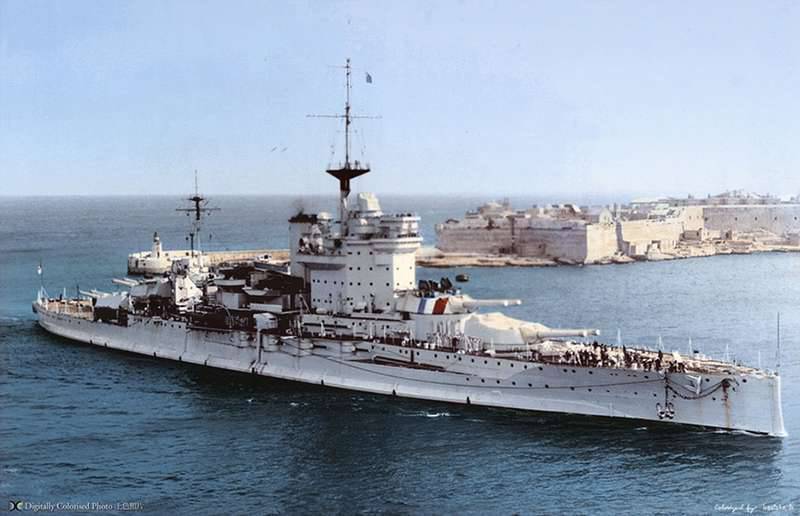
Unfortunately for the Italian command, the British had a slightly different view on the use of large ships and fleets in general. Already in the first armed clash at Calabria Cape 10 in July 1940, the only hit of an 381-mm projectile from the Worspite to Cesare caused a fire, the smoke from which the fans swallowed into the engine room, because of which they had to partially evacuate personnel - this hit led to a fleeting end to the battle. The stake on coastal aviation was untenable - the British Sunderland flying boats absolutely brazenly and with impunity hung over the Italian squadron, despite the insistent requests of Admiral Campioni to send fighters and bombers. And just four months later, the British did not inflict an easy educational slap, but a full blow, besides below the belt. On the night of 11 on 12 in November 1940, the 21 torpedo bomber "Suordfish" from the aircraft carrier "Illastries" visited the main base of the Italian Navy Taranto. The outcome of the visit was more than impressive: the British pilots, at the cost of killing just two aircraft, managed to disable three battleships, including the newest Littorio. “Cavour”, sunk in shallow water, no longer went out to sea, “Kayo Duilio” spent months in repair 5. The last skeptics who arrogantly treated aircraft carriers as servants of battleships in reconnaissance or as air transport, were forced to admit that they were wrong.
The raid on Taranto and the sea battle at Spartivento, which was generally favorable for the British, made it possible to drag the situation to its side and provide General Wavelew in Egypt with all the necessary for a counter-offensive against the Italian army that had invaded Libya. The merciless defeat of the 150-thousandth group of Marshal Graziani, the impressive successes of British troops in Italian East Africa were very strong arguments against the realization of the dream of a New Roman Empire. Duce had to postpone the already tried on crown of Julius Caesar and seek help from the German allies. Hitler, whose thoughts were swallowed up by a huge country in the east, did not want to go to Africa for the time being, but it was necessary to urgently support the rapidly falling Italian pants. Already in February, the “rescue team” represented by the avant-garde of the 5 light division of the German African corps landed in Tripoli. In the Balkans, the ground was prepared for the solution of the question of the existence of Yugoslavia and Greece. The command of the Italian fleet has undergone the expected shuffling - someone must be guilty of so many failures and failures. The place of commander headquarters Cavagnari took Admiral Riccardi. The acting forces were headed by Admiral Angelo Iakino, who previously had a good reputation as commander of a cruiser division. Before the war, Iakino was a naval attache in London and was thought to know the British mentality and their fleet well.
14 – 16 February in Merano, a meeting was held between the tops of two allied fleets - Grand Admiral Raeder and Admiral Riccardi. The Germans, who were very concerned about the appearance of the British in Greece, insisted on the active actions of the Italian fleet. Riccardi maneuvered, complaining about the remoteness of their own bases and the saving umbrella of coastal aviation. In addition, the fleet has already experienced stress with fuel. On this complaint, Raeder objected that soon the Greek Halifax and Wellington might be on Greek airfields, which are quite capable of reaching the Ploiesti oil-bearing regions, and that then the fuel could become quite bad. Ricardi promised assistance.
In early March, the Germans, whose reconnaissance aircraft fixed the increasing flow of transports to Greece, began to put pressure on the allies with a simple goal: to make the Italian fleet forget about cuffs and crackles and go to sea. In order to block the possible excuses of the “new Romans”, who were so worried about the safety of their “triremes”, they were promised help in the person of the German X Air Corps, whose pilots had sufficient experience of flying over the sea. Closer to the Aegean Sea, the squadron should have been picked up by fighters from Rhodes. The Germans reassured their Axis colleagues, telling that 16 in March two British battleships were damaged by torpedoes. Of course, this was not true. Iakino calmed down, although he didn’t quite understand the deliberate need for such an operation - the results could turn out to be zero, and the ships would burn a lot of fuel. But from above they pressed. Until the signing of the directive number 25 on the attack on Yugoslavia and Greece, there were only a few days left. In the evening of March 26, the Italian fleet set sail.
Fleet out
Admiral Iakino left Naples, holding a flag on the newest "Vittorio Veneto." His nine 380-mm guns in the three main-caliber towers personified reliability and instilled confidence. Four bodyguards alongside the flagship were escort destroyers. “Heavy cavalry” also moved ahead: the 3-division of cruisers (“Trieste”, “Trento”, “Bolzano”) and three destroyers. Taranto left the 1-division of cruisers (Zara, Paul, Fiume), and light forces slipped out of Brindisi - 8-division of cruisers (Abruzzi, Garibaldi) accompanied by six destroyers. All connections were to be met in 60 miles east of Augusta.
Secret fears and anxieties often tend to be carried out. As secretly and assumed Iakin, the next day the sky over the squadron was free from the promised aircraft X aircraft corps. But in 12 h. 25 min. Trieste reported that it was observing the English Flying Boat Sunderland. The intensive work of the radio transmitter was recorded on it. The messages were deciphered, and the Italians learned that only three heavy cruisers and the destroyers accompanying them were found from the plane. The fog did not allow to detect the rest of the ships Iakino. However, the news of the detection of enemy ships was most carefully received in Alexandria, the main base of the British Navy at that time. Admiral Andrew Cunningham, comparing the increased activity of the Italian-German aircraft in recent days and the launch of enemy cruisers at sea, came to the very clear conclusion that the enemy was preparing some kind of operation in the waters of Greece. Fortunately, at that time only one convoy (AG-9) was at sea, and he was ordered to follow the same course before dark, and then turn back. The exit of the next convoy was delayed. Realizing that the observed cruisers can only be part of a squadron that went into the sea, Cunningham nevertheless prepared to go to sea to give battle. Vice-Admiral Coming-Whippell (Orion, Ajax, Perth, Gloucester, destroyer 4), operating in the Aegean Sea, received an order in the morning of March 28 to be at the meeting point south-west of Gavdos Island.
The main forces of the Mediterranean fleet, meanwhile, were preparing to leave Alexandria. Cunningham himself tried as far as possible to conceal from the enemy’s intelligence his intention to go to sea. So, in the afternoon, he left the board of the "Worspite" with a suitcase, allegedly intending to spend the night on the beach. However, shortly after dark, he returned to the flagship. Late in the evening the British squadron went to sea. He headed his permanent veteran "Worspayt" under the flag of Cunningham. Two more young but experienced fighters marched along with him - the battleships “Valiant” and “Barem”. British battleships were inferior in speed to their Italian opponents, especially the newest ones, but they had powerful 380-mm artillery. However, the British had a trump ace, which they did not particularly hide. Cunningham's squadron included the newest aircraft carrier, the Formidebl, which came into service only four months ago and arrived in Alexandria on March 10. It was a ship with a displacement of 23 thousand tons, having an armored deck and hangars. In the afternoon of March 27, his air group relocated aboard from the base of Dekheyl three miles from Alexandria. Large ships escorted 9 destroyers.
The Italian plan called for advancing into the Aegean Sea, reaching the eastern tip of Crete with most of the cruisers (1 and 8 division) under the cover of "Vittorio Veneto" and in the case of non-detection of the enemy go to the opposite course. Thus, the operation in its essence did not go beyond the usual principle of Britain’s opponents at sea — not to risk ships. Especially careful search and a long stay in the Greek waters were not provided. All the next day of 27 March, the Italians continued to move east and at nightfall they increased the speed to 23 nodes. A reconnaissance aircraft from Rhodes reported to Iakino that he found three battleships, two aircraft carriers and other ships in the harbor of Alexandria. The British were anchored, and this calmed the admiral a little. At 6 in the morning hours of March 28, with Vittorio Veneto, the reconnaissance aircraft Ro-43 was catapulted with an order to reconnoiter and then land on the island of Leros. A little later, his scout raised and heavy cruiser "Bolzano". If they didn’t find anything by 7 in the morning, Jakino planned to reverse the course.
In 6 h. 43 min. The battleship's seaplane radioed on the Vittorio Veneto about the discovery of four cruisers and four destroyers on a course to the southeast of all in any 50 miles. These were the ships Come-Whippella. After another 40 minutes, the English scout referred to the "Worspite" that they had Italian cruisers fixed. Cunningham ordered the battleship's speed to be increased to 22 knots, which is the maximum that the vehicles of the old ship were capable of. Tension on the British squadron subsided - it became obvious that the enemy at sea and the much-desired battle could hardly be avoided. Having received the reconnoitered, extracted by the Formidebl aircraft, We will come to Whippell at first thought that it is a question of its connection, however in 7.45 with Orion they found smoke behind the stern. In 7.58, the heavy cruiser Trieste visually identified the enemy — its presence no longer doubted both squadrons. In 8 h. 12 min. from the distance 25000 meters Italians opened fire and, taking advantage of their high speed, began to shorten the distance. We'll come - Whippell began the march to his main forces, intending to lure the enemy closer to his battleships. They were already on their way to the battlefield, holding the 22 hub, the senior mechanic at Worspite reported that the old man was capable of giving 24, but Barem was not capable of such speed, and Cunningham had to limit the squadron speed.
The distance between the two groups of cruisers was reduced, the Italians concentrated fire on the terminal Gloucester - on the eve the ship had an accident in the engine room and could not reach full speed. Eight-inch volleys lay quite tightly around the British, but the ships of the 3-th division did not achieve a single hit. In 8 h. 55 min. Italian cruisers described the circulation and left the battlefield, turning back. They fulfilled Jacobin’s order not to move too far from the battleship patronizing them. Seeing a change in the behavior of the enemy, Let's come to Whippell also turned back, trying to maintain visual contact with the enemy. Cunningham’s battleships were no more than 50 miles. Neither the commander of the 3 Division, Vice-Admiral Sansonetti, nor Norde-Whipple were aware of the nearby Italian and English battleships. In the 10.58 from the Orion cruiser, at a distance of 16 miles, they found a ship that looked like a battleship. Soon he was identified as a battleship of the type "Vittorio Veneto", which immediately opened fire. Having met such a strong and unexpected opponent, the English cruisers, having set up a smoke screen, turned away.
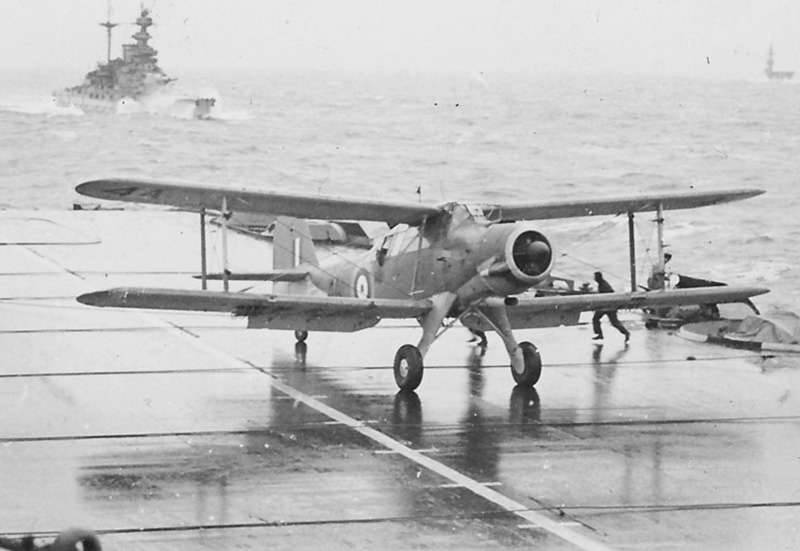
While the front cruising groups were in contact with fire, work was in full swing on the Formidebla deck. Aviation was to join the battle. The first in the case were "Suordfish" from Malia airbase (Crete). In obedience to Cunningham's orders, they unsuccessfully attacked the cruiser Bolzano, which easily turned away from the torpedoes. The word was for the deck air group, which was already in readiness from early morning. In 9 h. 36 min. The Formideb stood up against the wind, and six Albacores (torpedo-bearers) and two Fulmar (a deck-based fighter capable of carrying a torpedo) climbed from it, roaring with engines. The English cruisers at that time had to endure unpleasant moments - not only did the battleship firing at them, whose volleys lay closer and closer, also Sonsonetti turned his ships to join the attack on the enemy. At this critical moment, Formidla aircraft appeared in 11.27. At Vittorio Veneto, they were initially mistaken for a long-awaited destructive cover from Rhodes (Albacore biplanes were mistaken for Falco CR-42), but the joy soon gave way to disappointment. The torpedo bombers began to attack the battleship moving with the 30-nodal stroke, barked 20- and 37-mm Breda anti-aircraft guns, the flagship Iakino began to maneuver, evading six torpedoes launched at him. The British did not hit, but Let's come, Whippell managed to avoid an enemy attack. The air around the Italian squadron was obviously tense, and its commander ordered the retreat to the bases.
"Great God, and yet we hit!"
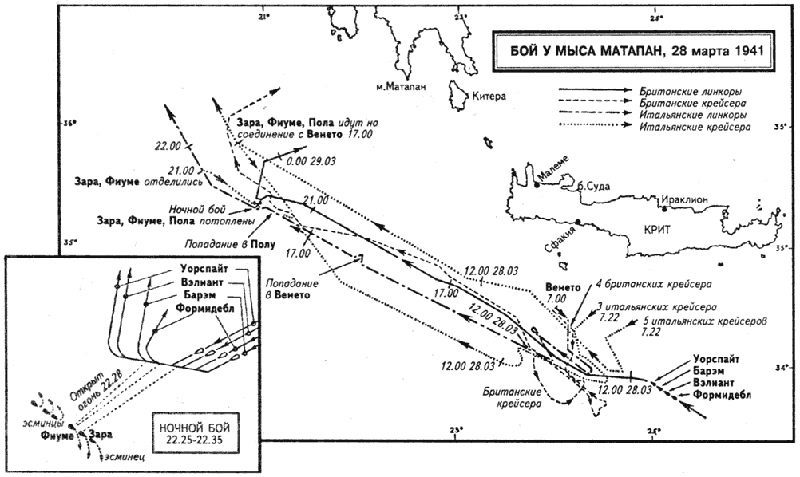
The distance between the two squadrons was no more than 50 miles, but the Italians retreated 28-nodal course. Cunningham could not afford to develop more than 22 because of the low-speed "Barem". Iakino spurred the presence of the enemy aircraft (it does not matter, they flew from Crete, or, worse, from the aircraft carrier) and the lack of air cover. The chance to catch up with the enemy leaving at high speed was to make him slow down. This could be achieved by damaging the Italian battleship - it certainly would not have been abandoned. Therefore, now much depended on the skill of the pilots. At the time of the battle, Formidebl had 27 airplanes (13 Fulmar, 10 Albacor and 3 Suordfish). He, along with two destroyers, separated from the main forces, so as not to hamper Cunningham’s battleships with his maneuvers, and took the second wave into the air - the 3 “Albacore” and the 2 “Suordfish”. Their attack on the cruisers of the 3 Division also ended without result. Having received the first aircraft, and then the next wave, the aircraft carrier went to catch up with the main forces, which it soon joined. His planes were preparing for new sorties - for the time being they were refueled, examined and re-equipped. Contact with the Italian squadron was restored around 14 hours, when she was again discovered from the air. At the beginning of the third, Blenheim bombers, which flew from Greek airfields, attacked it. And again - only close gaps and the lack of direct hits. No sooner had the calculations of anti-aircraft guns taken breath, how did the Albacores and Fulmar appear in the air. While fighters poured their battery of eight 7,7-mm and four 12,7-mm machine guns superstructure "Vittorio Veneto", disorienting observers and defense calculations, link "albacore", led by Lieutenant Commander Dale Steed, squadron commander 829-Squadron, pick up the battleship to an extremely close distance. The lead torpedo bomber under a hurricane fire dropped its cargo in some 100 meters from the side. In the next moments, he was riddled with an anti-aircraft gun and collapsed into the water. From the torpedo "Vittorio Veneto" could not dodge - she got into the left side of the stern of the ship. There was an explosion, about 4 thousand tons of water entered the hole. In 15.30, the battleship's cars stopped, he slowly began to roll, sinking stern. For his feat, Lieutenant Daylil-Steed was posthumously awarded the Order of Distinguished Service.
Emergency parties on the flagship Iakino immediately rushed to fix the damage. Using the starboard machine group, the ship was soon able to give 10 nodes, then develop 19. Before Taranto, 420 was still miles away, and there was not a single Italian or German aircraft in the sky. Fearing new attacks, Jakino built his squadron so that the damaged battleship was now in its center — cruisers marched to its left and right, and the destroyers formed an outer perimeter. The British received numerous, but contradictory information about the location of the enemy from different reconnaissance aircraft. In the end, the 17.45 from Worspite raised the Suordfish onboard float with an experienced observer aboard, who in 18.10 discovered Vittorio Veneto in 45 miles from his battleship, and already in 18.25, nine Albacores appeared above the Italian squadron . They circled behind the enemy's stern outside the zone of destruction of its fire. Above hovered a scout from the "Worspite", constantly transmitting data. It was already dark when the British rushed to the attack in 19.20. Anti-aircraft fire was very strong, and failed to break through to the flagship, however, the heavy cruiser "Paul" was damaged by a torpedo at 19.46, which soon lost its course. Having only coastal intelligence reports, according to which the British cruisers were spotted in 75 miles behind, the Italian commander did not even know about the presence of battleships.
Under such conditions, assuming that there will be no more air attacks from the night, and the likelihood of meeting with enemy large ships is vanishingly small, in 20.18 Iakino issues an order to the 1 division of Vice-Admiral Cattaneo's cruisers to turn back and assist the damaged "Field". The counter-offer of the divisional commander limited to two destroyers Iakino rejected. Heavy cruisers "Zara" and "Fiume" together with four destroyers changed course, following the order of the commander. They went straight to meet the English squadron. Cunningham deliberately took risks in an effort to impose battle and finish off a wounded enemy, although each mile to the west increased the danger of meeting with enemy aircraft. However, despite the entreaties of the headquarters, the British admiral was determined.
In 20 h. 32 min. one of the cruisers We will come to Whippella "Ajax" radar discovered the immobile "Paul." After receiving the message, Cunningham ordered his battleships to turn and go for a rapprochement, following the wake column. On 22.03, the “Valiant” radar received contact with a target that was no more than 8 – 9 miles from it. The British at first thought hopefully that it was a damaged Vittorio Veneto. The British battleships made a turn "all at once" and now they were in line of bearing. In 22.23, the destroyer Stuart reported that he saw new targets following a column crossing the British course. In 22.27, the destroyer Greyhound illuminated the new arrivals with a searchlight. It was Vice-Admiral Cattaneo’s 1 Division. The towers of the Italian cruisers were turned to zero - they did not even suspect the enemy.
In 22 h. 30 min. British battleships opened fire from a distance of almost three kilometers, which practically negated the blunders. The first volley of the Worspite (five out of six 380-mm projectiles) hit Fiume. The battleship commander, captain of 1 rank Douglas Fisher, himself a former artilleryman, exclaimed: “Great God, we did!” Cunningham subsequently recorded this expression. But the Italians were not joking - the British shells smashed the enemy, quickly turning it into a pile of floating debris. Having made several volleys, the British dodged torpedoes fired by enemy destroyers who tried to counterattack. There was a brawl light forces, the result of which was the death of two Italian destroyers. Two managed to leave. Caught in flames, Fiume sank in 23.15, at half past midnight the torpedoes of the destroyer Jervis were finished off and the burning Zara exploded. Admiral Cattaneo and the cruiser commander were killed along with the ship.
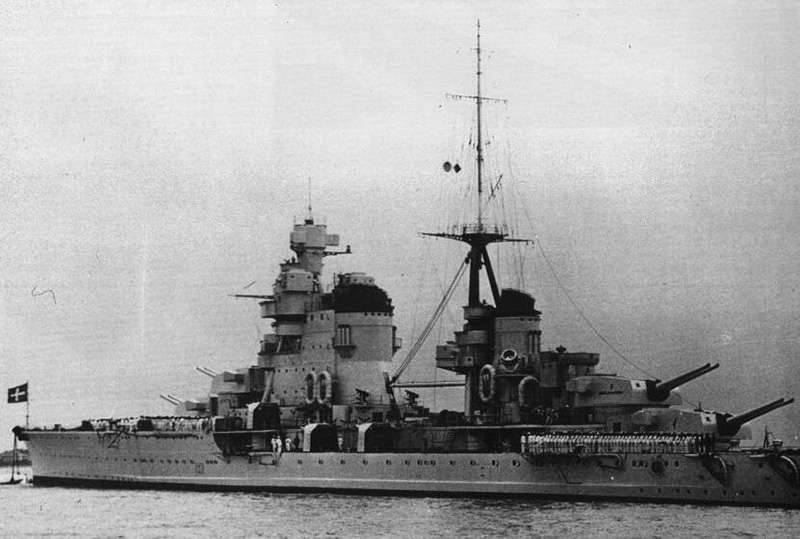
In 23 hours, Cunningham gave an order to all ships not engaged in the destruction of the enemy, to depart to the north and northeast. In 00.20, the destroyer "Haywok" again discovered the drifting "Paul", which no one had paid attention to before. The cruiser was in a joyless state, half submerged astern. The destroyer Jervis, who approached and moored to its board, found the Paul in a helpless position: chaos reigned on the ship, part of the crew had already left it, some were crowded on the deck, and many were not quite sober. Having removed a crew man from the 257 cruiser, the British finished him off with torpedoes. At the site of the night battle, the British destroyers carried out rescue work until the morning, until the German Ju-88 appeared on them, after which they had to start the withdrawal. The main forces left the battlefield at night. There were a lot of Italians in the water, and Admiral Cunningham sent a Formidla plane to Crete with a radiogram that should have been sent to Malta, and then to the Italian command. It contained the coordinates of the place where the sailors from the dead cruisers and destroyers were still located.
An attempt to hunt for the English convoys cost the royal navy three heavy cruisers and two destroyers. The battleship was damaged. Archaic methods of warfare at sea, ignoring the role of aircraft carriers, the complete absence of air cover, naturally led the Italian fleet to defeat, from which it did not fully recover until the end of the war.
Information